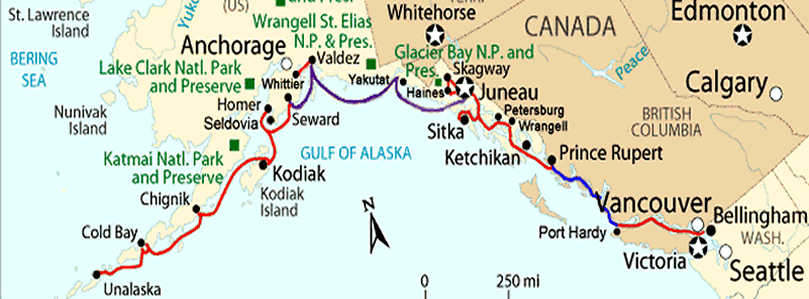Taxpayers are often told that America’s infrastructure is crumbling, rusting, or even derelict. Not a State of the Union Address goes by without the President pledging to spend billions more on bridges, tunnels, and ports. We’re left thinking that at any time, our morning commutes or vacation plans will be stopped short by a one catastrophe or another involving the nation’s roads, waterways, or skyways.
But what if you had a solution that was funded and ready to go, but hamstrung by regulations? That’s the situation the state of Alaska faces right now.
A Highway for Ferries
The Alaska Marine Highway is a series of ports along the American and Canadian west coasts that connects the Last Frontier State to the lower 48. From Bellingham, Washington to the Unalaska Island (in the Aleutians), the 3,500-miles of channels and open seas are traveled by 312,000 passengers (commuters and tourists) every year. All but one of the 12 ports is in U.S. territory; the Prince Rupert terminal lies in the Canadian province of British Columbia.

Alaska has leased the Canadian port since 1963 and has recently renewed the agreement for 50 more years. After decades of constant use, the terminal is in need of repair; specifically the moorings, bridges, and vehicle ramps need to be replaced. Alaska’s state government pledged between $10 million and $20 million to rebuild the port that is the first stop for ferries coming from Washington State.
The Plan Goes Overboard
 Because the port is located in another country, Alaska can’t just transfer the funds and potentially help restore the terminal. The international nature requires the federal government to approve the project and to ensure project plans comply with existing regulations. Here’s where the problems arise.
Because the port is located in another country, Alaska can’t just transfer the funds and potentially help restore the terminal. The international nature requires the federal government to approve the project and to ensure project plans comply with existing regulations. Here’s where the problems arise.
The plan was for a British Columbian firm to handle the project, and as any firm would do, they intended to seek out the best materials at the cheapest price. However, the U.S. government’s “Buy America” rules prevent certain overseas purchases and have put the entire project in jeopardy.
Enacted in a variety of bills since 1933, the federal government has dictated that federally-funded infrastructure projects be supplied with American-made steel, iron, and manufactured goods. Used as a protectionist measure to keep U.S.-based (and often more expensive) companies in business, the “feel good” regulation is now putting the Price Rupert terminal project on hold, possibly causing the entire venture to be cancelled.
Because the federal Department of Transportation is footing most of the bill, Canadians are asking why they must use American materials (not made anywhere near British Columbia) instead of rebuilding the terminal with a variety of similar but cheaper products from China, Japan, or even Canada. Until Alaska Governor Bill Walker and/or the feds waive the Buy America regulations or, more unrealistically, American products become more competitively-priced, the terminal project is on hold. Canada has reacted by using their own sanctions law that prohibits companies complying with Buy America from participating in the project. This means those infrastructure woes politicians keep mentioning won’t go away anytime soon.
Some Alaskans point to the lower numbers of passengers passing through Price Rupert pier and are calling for the entire project to be shuttered.
Buy America or Buy into Trade?
There are a few things Alaskans need to consider in the Prince Rupert debate:
Costs vs. Benefits: The $15 million price tag of the pier rebuild is not a small sum of tax dollars. With a FY 2016 $3.5 billion projected revenue shortfall, Alaskans need to consider whether or not the money (coming from the federal or state level) would be best spent on the Price Rupert project.
Seen vs. Unseen: On the one hand, the project would expand U.S.-Canada trade while ensuring that the Prince Rupert pier is usable for the coming decades. On the other, money could go to other projects and would require the Canadian government to refit the terminal (as they receive tax dollars from sales and the lump sum of the lease). $15 million could go a long way towards improving area bridges, roads, or shoring up state education budgets.
Greater Trade Implications: This instance is yet another example of why the Buy America provision hurts instead of helps America. Instead of letting a project receive funding that could generate more economic development for Alaska, Washington State, and British Columbia, governments are instead opting to use 19th century trade tactics in a 21st century world. If American steel is too expensive or it is economically unfeasible to transport competitively priced domestic materials all the way out to Canada’s west coast, alternatives should be embraced. The lower cost of similar goods help the Canadian builders do a more efficient job, give Alaska and American taxpayers a bigger bang for their buck, and gives both nations confidence when dealing with future international construction projects. Free trade is a win-win situation for the parties involved.
Who Benefits: Buy America laws help struggling industries like metal works and textile producers. Though there is a certain value to helping a domestic company make more materials (realized in jobs, economic activity, and exports), the protectionist stances the industries have raised have insulated them from foreign competition. The need to innovate and compete to develop a better product has been replaced with lobbying legislators to prevent foreign goods from entering domestic markets and pushing for more “stimulus” spending, when they are in fact the direct beneficiaries of greater infrastructure improvements.
Perhaps the biggest lesson of this episode is that trade policies that don’t take into account real-world realities are destined to fail or hinder our potential for a better world. By sticking with Buy America rules, we refuse to buy into the free-trade world that America helped create.

